
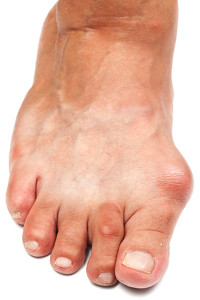 A large bony bump on the side of the big toe is referred to as a bunion. It can occur as a result of genetic factors, and from shoes that are worn which do not fit correctly. There may be inadequate room for the toes to move freely in, and this may cause the big toe to gravitate to the toe next to it. There are common symptoms that are often associated with bunions, including red and hardened skin over the affected toe, and it may be difficult to move and to wear shoes. Mild relief can be found when larger shoes are worn, and it may be helpful to wear a protective pad on top of the toe. For severe bunions, surgery could be a successful treatment option for permanent removal. If you are afflicted with a bunion, it is suggested that you seek the counsel of a podiatrist who can properly manage this condition.
A large bony bump on the side of the big toe is referred to as a bunion. It can occur as a result of genetic factors, and from shoes that are worn which do not fit correctly. There may be inadequate room for the toes to move freely in, and this may cause the big toe to gravitate to the toe next to it. There are common symptoms that are often associated with bunions, including red and hardened skin over the affected toe, and it may be difficult to move and to wear shoes. Mild relief can be found when larger shoes are worn, and it may be helpful to wear a protective pad on top of the toe. For severe bunions, surgery could be a successful treatment option for permanent removal. If you are afflicted with a bunion, it is suggested that you seek the counsel of a podiatrist who can properly manage this condition.
If you are suffering from bunions, contact Dr. Stephan J. LaPointe of Georgia Foot & Ankle Specialists . Our doctor can provide the care you need to keep you pain-free and on your feet.
What Is a Bunion?
A bunion is formed of swollen tissue or an enlargement of boney growth, usually located at the base joint of the toe that connects to the foot. The swelling occurs due to the bones in the big toe shifting inward, which impacts the other toes of the foot. This causes the area around the base of the big toe to become inflamed and painful.
Why Do Bunions Form?
Genetics – Susceptibility to bunions are often hereditary
Stress on the feet – Poorly fitted and uncomfortable footwear that places stress on feet, such as heels, can worsen existing bunions
How Are Bunions Diagnosed?
Doctors often perform two tests – blood tests and x-rays – when trying to diagnose bunions, especially in the early stages of development. Blood tests help determine if the foot pain is being caused by something else, such as arthritis, while x-rays provide a clear picture of your bone structure to your doctor.
How Are Bunions Treated?
If you have any questions, please feel free to contact our office located in Rome, GA . We offer the newest diagnostic and treatment technologies for all your foot care needs.
The plantar fascia is located on the bottom of the foot. It is a band of tissue that connects the heel to the toes, and if it should become damaged and inflamed, a condition that is known as plantar fasciitis may develop. Common symptoms that are associated with this ailment often include severe pain and discomfort, and it may cause difficulty in walking. It typically originates from overuse from running activities, or as a result of being overweight. Relief may be found when specific stretches are performed that will strengthen the plantar fascia. These consist of stretching the calf, which may be helpful in relieving muscle tightness in the Achilles tendon and heel area. Some patients find it beneficial to roll the arch of the foot on a tennis or golf ball, in addition to pointing and flexing the foot. If you have heel pain, please consult a podiatrist who can guide you toward the treatment that is correct for you.
Plantar fasciitis is a common foot condition that is often caused by a strain injury. If you are experiencing heel pain or symptoms of plantar fasciitis, contact Dr. Stephan J. LaPointe from Georgia Foot & Ankle Specialists . Our doctor can provide the care you need to keep you pain-free and on your feet.
What Is Plantar Fasciitis?
Plantar fasciitis is one of the most common causes of heel pain. The plantar fascia is a ligament that connects your heel to the front of your foot. When this ligament becomes inflamed, plantar fasciitis is the result. If you have plantar fasciitis you will have a stabbing pain that usually occurs with your first steps in the morning. As the day progresses and you walk around more, this pain will start to disappear, but it will return after long periods of standing or sitting.
What Causes Plantar Fasciitis?
There are some risk factors that may make you more likely to develop plantar fasciitis compared to others. The condition most commonly affects adults between the ages of 40 and 60. It also tends to affect people who are obese because the extra pounds result in extra stress being placed on the plantar fascia.
Prevention
There are a variety of treatment options available for plantar fasciitis along with the pain that accompanies it. Additionally, physical therapy is a very important component in the treatment process. It is important that you meet with your podiatrist to determine which treatment option is best for you.
If you have any questions, please feel free to contact our office located in Rome, GA . We offer the newest diagnostic and treatment technologies for all your foot care needs.
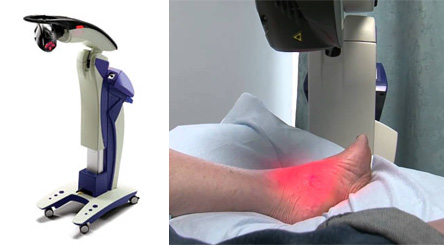 Patients who have chronic foot pain may understand the benefits of receiving shockwave therapy. It can be helpful in alleviating pain that comes from plantar fasciitis. There are two forms of this type of treatment, and they are known as high and low energy. The former is administered in three or more sessions, which are generally not painful. The latter is often given with a form of anesthesia, and can produce severe pain and discomfort. Both forms of this type of treatment use pressurized air or electromagnetic pulses which may be effective in reducing a portion of chronic foot pain from plantar fasciitis. If you have this type of foot pain, it is suggested that you schedule a consultation with a podiatrist who can help you in determining if this type of treatment is correct for you.
Patients who have chronic foot pain may understand the benefits of receiving shockwave therapy. It can be helpful in alleviating pain that comes from plantar fasciitis. There are two forms of this type of treatment, and they are known as high and low energy. The former is administered in three or more sessions, which are generally not painful. The latter is often given with a form of anesthesia, and can produce severe pain and discomfort. Both forms of this type of treatment use pressurized air or electromagnetic pulses which may be effective in reducing a portion of chronic foot pain from plantar fasciitis. If you have this type of foot pain, it is suggested that you schedule a consultation with a podiatrist who can help you in determining if this type of treatment is correct for you.
Shockwave therapy is a treatment commonly used to treat various injuries and conditions, particularly plantar fasciitis in the feet. To learn more, consult with Dr. Stephan J. LaPointe from Georgia Foot & Ankle Specialists . Our doctor can provide the care you need to keep you pain-free and on your feet.
Shockwave Therapy
Shockwave therapy is a new treatment option designed to treat bone conditions such as tennis elbow, shoulder pain, and others. Shockwave therapy uses high intensity sound waves that are directed to the affected tissues of the body with pinpoint accuracy. The effects are very beneficial, leading to a production of collagen fibers, eliminating inflammation.
Who Benefits from Shockwave?
Shockwave is recommended for patients suffering from heel pain and associated problems. Heel pain is a common condition which can be caused by obesity, overexertion, and spending a substantial amount of time on hard floors with your feet exposed and unsupported.
Fast and Easy
The therapy is actually a simple process that can leave patients feeling better the very next day. Shockwave therapy is not as dramatic as it sounds. It enables more blood flow to effected areas, addressing the source of the problem and allowing treatment to last for a long time.
Treatment & Recovery Time
Shockwave treatment will enable your feet to recover quickly. This is especially important since surgery is not required. It is cost effective and does not require the use of anesthesia. This treatment is a better option to surgery, since it is proven safe.
If you have any questions, please feel free to contact our office located in Rome, GA . We offer the newest diagnostic and treatment technologies for all your foot and ankle needs.
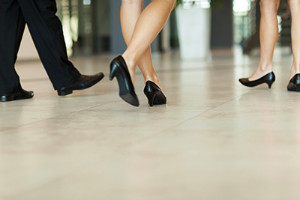 Many people experience painful foot conditions as the aging process occurs. Standing and walking for the majority of the day can put unwanted pressure on the feet, so there are measures that can be taken which may help to prevent foot ailments. These can include wearing shoes that fit correctly, and making sure there is adequate room for the toes to move freely in. When the feet are frequently moisturized, uncomfortable skin conditions may be avoided. Additionally, people who stand for extended periods of time may benefit from performing gentle stretching techniques throughout the work day. Trimming the toenails correctly can aid in preventing ingrown toenails and practicing good foot hygiene can help the feet to feel good. If you would like additional information about proper foot care, it is suggested to consult with a podiatrist.
Many people experience painful foot conditions as the aging process occurs. Standing and walking for the majority of the day can put unwanted pressure on the feet, so there are measures that can be taken which may help to prevent foot ailments. These can include wearing shoes that fit correctly, and making sure there is adequate room for the toes to move freely in. When the feet are frequently moisturized, uncomfortable skin conditions may be avoided. Additionally, people who stand for extended periods of time may benefit from performing gentle stretching techniques throughout the work day. Trimming the toenails correctly can aid in preventing ingrown toenails and practicing good foot hygiene can help the feet to feel good. If you would like additional information about proper foot care, it is suggested to consult with a podiatrist.
While working on the feet, it is important to take the proper care of them. For more information about working on your feet, contact Dr. Stephan J. LaPointe from Georgia Foot & Ankle Specialists . Our doctor will treat your foot and ankle needs.
Working on Your Feet
Standing on your feet for long periods of time can cause stress and pain in your feet. Your whole body may experience change in terms of posture, back pain, bunions, callouses and or plantar warts. There are ways to avoid these conditions with proper foot care, smart choices and correct posture.
Positive Changes
Negative heeled shoe – Choosing this shoe type places the heel slightly lower than the ball of the foot. These are great for overall foot health. Find shoes that fit you correctly.
Go barefoot – Our feet were not designed to be enclosed for all hours of the day. Try to periodically expose your feet to air.
Eliminate Pain
Foot Exercises – Performing simple exercises, incorporating yoga and doing stretches are beneficial. This will allow increased blood flow to the area and muscles of the foot.
Achilles tendon – Stretching the foot out flat on the floor will relax the calf muscles and tendon. These exercises can be performed almost anywhere. Make sure you add these exercises to your daily regimen.
With a little bit of this information and knowing more about foot health, you will notice changes. Foot stretches and proper footwear will help with pain and prevent further issues.
If you have any questions please feel free to contact our office located in Rome, GA . We offer the newest diagnostic and treatment technologies for all your foot and ankle needs.
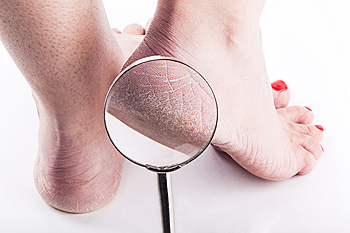 Many patients experience dry skin on the heels, and this is often the result of a lack of moisture in the skin on the feet. There are several reasons why this condition may develop. These consist of standing for extended periods of time throughout the day, wearing shoes that have an open back, or from being overweight. Additionally, there may be existing medical conditions that may contribute to the onset of cracked heels, which can include psoriasis, diabetes, or hypothyroidism. Mild relief may be found when the feet are washed and dried daily, followed by using a good moisturizer. If the cracks on the skin become severe, and appear to be deep, it is suggested to consult with a podiatrist who can recommend proper treatment options.
Many patients experience dry skin on the heels, and this is often the result of a lack of moisture in the skin on the feet. There are several reasons why this condition may develop. These consist of standing for extended periods of time throughout the day, wearing shoes that have an open back, or from being overweight. Additionally, there may be existing medical conditions that may contribute to the onset of cracked heels, which can include psoriasis, diabetes, or hypothyroidism. Mild relief may be found when the feet are washed and dried daily, followed by using a good moisturizer. If the cracks on the skin become severe, and appear to be deep, it is suggested to consult with a podiatrist who can recommend proper treatment options.
If the skin on your feet starts to crack, you may want to see a podiatrist to find treatment. If you have any concerns, contact Dr. Stephan J. LaPointe from Georgia Foot & Ankle Specialists . Our doctor can provide the care you need to keep you pain-free and on your feet.
Cracked Heels
It is important to moisturize your cracked heels in order to prevent pain, bleeding, and infection. The reason cracked heels form is because the skin on the foot is too dry to support the immense pressure placed on them. When the foot expands, the dry skin on the foot begins to split.
Ways to Help Heal Them
Ways to Prevent Cracked Heels
If you are unsure how to proceed in treating cracked heels, seek guidance from a podiatrist. Your doctor will help you with any questions or information you may need.
If you have any questions, please feel free to contact our office located in Rome, GA . We offer the newest diagnostic and treatment technologies for all your foot care needs.
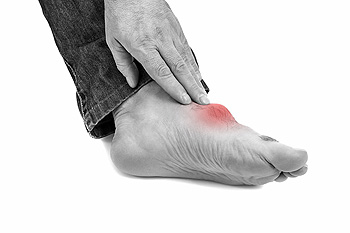 The medical condition that is referred to as gout is a painful ailment that affects the feet. More specifically, the joints in the big toe are typically distressed if this form of arthritis develops. It can cause severe pain and discomfort and may lead to joint deformities if it is not treated early. It occurs as a result of excess uric acid that exists in the blood levels. This may produce crystals that lodge in the joints of the big toe. This condition is typically caused by eating foods that are high in purine levels. These often include red meat, shellfish, and alcohol. There are methods that can be implemented, which may prevent gout attacks from occurring. These can consist of losing weight, performing a daily exercise routine, and eating healthy foods. If you are having pain in the big toe and surrounding areas and would like additional information about how gout affects the feet, please consult with a podiatrist.
The medical condition that is referred to as gout is a painful ailment that affects the feet. More specifically, the joints in the big toe are typically distressed if this form of arthritis develops. It can cause severe pain and discomfort and may lead to joint deformities if it is not treated early. It occurs as a result of excess uric acid that exists in the blood levels. This may produce crystals that lodge in the joints of the big toe. This condition is typically caused by eating foods that are high in purine levels. These often include red meat, shellfish, and alcohol. There are methods that can be implemented, which may prevent gout attacks from occurring. These can consist of losing weight, performing a daily exercise routine, and eating healthy foods. If you are having pain in the big toe and surrounding areas and would like additional information about how gout affects the feet, please consult with a podiatrist.
Gout is a painful condition that can be treated. If you are seeking treatment, contact Dr. Stephan J. LaPointe from Georgia Foot & Ankle Specialists . Our doctor will treat your foot and ankle needs.
What Is Gout?
Gout is a form of arthritis that is characterized by sudden, severe attacks of pain, redness, and tenderness in the joints. The condition usually affects the joint at the base of the big toe. A gout attack can occur at any random time, such as the middle of the night while you are asleep.
Symptoms
Risk Factors
Prior to visiting your podiatrist to receive treatment for gout, there are a few things you should do beforehand. If you have gout you should write down your symptoms--including when they started and how often you experience them, important medical information you may have, and any questions you may have. Writing down these three things will help your podiatrist in assessing your specific situation so that he or she may provide the best route of treatment for you.
If you have any questions, please feel free to contact our office located in Rome, GA . We offer the newest diagnostic and treatment technologies for all your foot care needs.
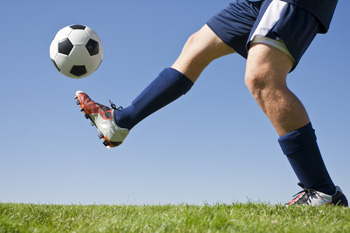 Athletes are known to have many foot and ankle complications. Some issues tend to affect the athletes of specific sports more than others. For example, “turf toe” is common among those who participate in football, soccer, basketball, wrestling, gymnastics, and dance. Turf toe is the spraining of the big toe joint. Another usual injury among athletes is a stress fracture. Those who run and jump on hard surfaces, such as runners, basketball players, and dancers, commonly experience fractures. Additionally, Achilles tendonitis, which is the inflammation of the back of your ankle, is seen among basketball and tennis players. Finally, a pinched nerve condition known as tarsal tunnel syndrome is seen among various types of athletes. Considering the extra stress athletes put on their bodies, it is no surprise that they are prone to foot and ankle injuries. These people in particular should look out for complications so they can continue performing in their respective sport effectively. If you believe you may have a foot or ankle injury due to a sport, you should contact a podiatrist.
Athletes are known to have many foot and ankle complications. Some issues tend to affect the athletes of specific sports more than others. For example, “turf toe” is common among those who participate in football, soccer, basketball, wrestling, gymnastics, and dance. Turf toe is the spraining of the big toe joint. Another usual injury among athletes is a stress fracture. Those who run and jump on hard surfaces, such as runners, basketball players, and dancers, commonly experience fractures. Additionally, Achilles tendonitis, which is the inflammation of the back of your ankle, is seen among basketball and tennis players. Finally, a pinched nerve condition known as tarsal tunnel syndrome is seen among various types of athletes. Considering the extra stress athletes put on their bodies, it is no surprise that they are prone to foot and ankle injuries. These people in particular should look out for complications so they can continue performing in their respective sport effectively. If you believe you may have a foot or ankle injury due to a sport, you should contact a podiatrist.
Sports related foot and ankle injuries require proper treatment before players can go back to their regular routines. For more information, contact Dr. Stephan J. LaPointe of Georgia Foot & Ankle Specialists . Our doctor can provide the care you need to keep you pain-free and on your feet.
Sports Related Foot and Ankle Injuries
Foot and ankle injuries are a common occurrence when it comes to athletes of any sport. While many athletes dismiss the initial aches and pains, the truth is that ignoring potential foot and ankle injuries can lead to serious problems. As athletes continue to place pressure and strain the area further, a mild injury can turn into something as serious as a rupture and may lead to a permanent disability. There are many factors that contribute to sports related foot and ankle injuries, which include failure to warm up properly, not providing support or wearing bad footwear. Common injuries and conditions athletes face, including:
Sports related injuries are commonly treated using the RICE method. This includes rest, applying ice to the injured area, compression and elevating the ankle. More serious sprains and injuries may require surgery, which could include arthroscopic and reconstructive surgery. Rehabilitation and therapy may also be required in order to get any recovering athlete to become fully functional again. Any unusual aches and pains an athlete sustains must be evaluated by a licensed, reputable medical professional.
If you have any questions please feel free to contact our office located in Rome, GA . We offer the newest diagnostic and treatment technologies for all your foot and ankle needs.
The medical condition that is known as plantar hyperhidrosis refers to feet that sweat excessively and frequently. Fungal skin infections including athlete’s foot can develop as a result of this condition, and a foul odor may exist. It is important to wear shoes and socks that are made of breathable materials, as this may help to control a portion of the sweating. Additionally, patients who are affected with this condition find it beneficial to wash and dry the feet daily, followed by using foot powder. Mild relief may be found when the socks are changed numerous times throughout the day.
If you feel you have this ailment, it is advised that you seek the counsel of a podiatrist who can properly diagnosis and treat plantar hyperhidrosis.
If you are suffering from hyperhidrosis contact Dr. Stephan J. LaPointe of Georgia Foot & Ankle Specialists . Our doctor can provide the care you need to attend to all of your foot and ankle needs.
Hyperhidrosis of the Feet
Hyperhidrosis is a rare disorder that can cause people to have excessive sweating of their feet. This can usually occur all on its own without rigorous activity involved. People who suffer from hyperhidrosis may also experience sweaty palms.
Although it is said that sweating is a healthy process meant to cool down the body temperature and to maintain a proper internal temperature, hyperhidrosis may prove to be a huge hindrance on a person’s everyday life.
Plantar hyperhidrosis is considered to be the main form of hyperhidrosis. Secondary hyperhidrosis can refer to sweating that occurs in areas other than the feet or hands and armpits. Often this may be a sign of it being related to another medical condition such as menopause, hyperthyroidism and even Parkinson’s disease.
In order to alleviate this condition, it is important to see your doctor so that they may prescribe the necessary medications so that you can begin to live a normal life again. If this is left untreated, it is said that it will persist throughout an individual’s life.
A last resort approach would be surgery, but it is best to speak with your doctor to find out what may be the best treatment for you.
If you have any questions please feel free to contact our office located in Rome, GA . We offer the newest diagnostic and treatment technologies for all your foot and ankle needs.